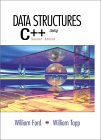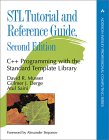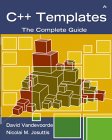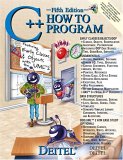|
Contents:
Related YoLinux Tutorials:
°Boost and STL list of pointers
°STL map and multimap
°C++ STL string class
°C++ Info, links
°C++ Memory corruption, leaks
°Software development tools
°C++ Coding Style
°Emacs and C/C++
°MS/Visual C++ tips and best practices
°YoLinux Tutorials Index
Free Information Technology Magazine Subscriptions and Document Downloads
Free Information Technology Software and Development Magazine Subscriptions and Document Downloads
|
vector: Dynamic array of variables, struct or objects. Insert data at the end.
Simple example of storing STL strings in a vector.
This example shows three methods of accessing the data within the vector:
-
#include <iostream>
#include <vector>
#include <string>
using namespace std;
main()
{
vector<string> SS;
SS.push_back("The number is 10");
SS.push_back("The number is 20");
SS.push_back("The number is 30");
cout << "Loop by index:" << endl;
int ii;
for(ii=0; ii < SS.size(); ii++)
{
cout << SS[ii] << endl;
}
cout << endl << "Constant Iterator:" << endl;
vector<string>::const_iterator cii;
for(cii=SS.begin(); cii!=SS.end(); cii++)
{
cout << *cii << endl;
}
cout << endl << "Reverse Iterator:" << endl;
vector<string>::reverse_iterator rii;
for(rii=SS.rbegin(); rii!=SS.rend(); ++rii)
{
cout << *rii << endl;
}
cout << endl << "Sample Output:" << endl;
cout << SS.size() << endl;
cout << SS[2] << endl;
swap(SS[0], SS[2]);
cout << SS[2] << endl;
}
|
Compile: g++ exampleVector.cpp
Run: ./a.out
Output:
-
Loop by index:
The number is 10
The number is 20
The number is 30
Constant Iterator:
The number is 10
The number is 20
The number is 30
Reverse Iterator:
The number is 30
The number is 20
The number is 10
Sample Output:
3
The number is 30
The number is 10
Two / Three / Multi Dimensioned arrays using vector:
A two dimensional array is a vector of vectors.
The vector contructor can initialize the length of the array and set the
initial value.
-
Example of a vector of vectors to represent a two dimensional array:
#include <iostream>
#include <vector>
using namespace std;
main()
{
// Declare size of two dimensional array and initialize.
vector< vector<int> > vI2Matrix(3, vector<int>(2,0));
vI2Matrix[0][0] = 0;
vI2Matrix[0][1] = 1;
vI2Matrix[1][0] = 10;
vI2Matrix[1][1] = 11;
vI2Matrix[2][0] = 20;
vI2Matrix[2][1] = 21;
cout << "Loop by index:" << endl;
int ii, jj;
for(ii=0; ii < 3; ii++)
{
for(jj=0; jj < 2; jj++)
{
cout << vI2Matrix[ii][jj] << endl;
}
}
}
|
Compile: g++ exampleVector2.cpp
Run: ./a.out
-
Loop by index:
0
1
10
11
20
21
A three dimensional vector would be declared as:
-
#include <iostream>
#include <vector>
using namespace std;
main()
{
// Vector length of 3 initialized to 0
vector<int> vI1Matrix(3,0);
// Vector length of 4 initialized to hold another
// vector vI1Matrix which has been initialized to 0
vector< vector<int> > vI2Matrix(4, vI1Matrix);
// Vector of length 5 containing two dimensional vectors
vector< vector< vector<int> > > vI3Matrix(5, vI2Matrix);
...
|
or declare all in one statement:
#include <iostream>
#include <vector>
using namespace std;
main()
{
vector< vector< vector<int> > > vI3Matrix(2, vector< vector<int> > (3, vector<int>(4,0)) );
for(int kk=0; kk<4; kk++)
{
for(int jj=0; jj<3; jj++)
{
for(int ii=0; ii<2; ii++)
{
cout << vI3Matrix[ii][jj][kk] << endl;
}
}
}
}
|
Using an iterator:
-
Example of iterators used with a two dimensional vector.
#include <iostream>
#include <vector>
using namespace std;
main()
{
vector< vector<int> > vI2Matrix; // Declare two dimensional array
vector<int> A, B;
vector< vector<int> >::iterator iter_ii;
vector<int>::iterator iter_jj;
A.push_back(10);
A.push_back(20);
A.push_back(30);
B.push_back(100);
B.push_back(200);
B.push_back(300);
vI2Matrix.push_back(A);
vI2Matrix.push_back(B);
cout << endl << "Using Iterator:" << endl;
for(iter_ii=vI2Matrix.begin(); iter_ii!=vI2Matrix.end(); iter_ii++)
{
for(iter_jj=(*iter_ii).begin(); iter_jj!=(*iter_ii).end(); iter_jj++)
{
cout << *iter_jj << endl;
}
}
}
|
Compile: g++ exampleVector2.cpp
Run: ./a.out
-
Using Iterator:
10
20
30
100
200
300
Constructor/Declaration:
-
| Method/operator |
Description |
| vector<T> v; |
Vector declaration of data type "T". |
| vector<T> v(size_type n); |
Declaration of vector containing type "T" and of size "n" (quantity). |
| vector<T> v(size_type n,const T& t); |
Declaration of vector containing type "T", of size "n" (quantity) containing value "t".
Declaration: vector(size_type n, const T& t) |
| vector<T> v(begin_iterator,end_iterator); |
Copy of Vector of data type "T" and range begin_iterator to end_iterator.
Declaration: template vector(InputIterator, InputIterator) |
Size methods/operators:
-
| Method/operator |
Description |
| empty() |
Returns bool (true/false). True if empty.
Declaration: bool empty() const |
| size() |
Number of elements of vector.
Declaration: size_type size() const |
| resize(n, t=T()) |
Adjust by adding or deleting elements of vector so that its size is "n".
Declaration: void resize(n, t = T()) |
| capacity() |
Max number of elements of vector before reallocation.
Declaration: size_type capacity() const |
| reserve(size_t n) |
Max number of elements of vector set to "n" before reallocation.
Declaration: void reserve(size_t) |
| max_size() |
Max number of elements of vector possible.
Declaration: size_type max_size() const |
Note: size_type is an unsigned integer.
Other methods/operators:
-
| Method/operator |
Description |
erase()
clear() |
Erase all elements of vector.
Declaration: void clear() |
erase(iterator)
erase(begin_iterator,end_iterator) |
Erase element of vector. Returns iterator to next element.
Erase element range of vector. Returns iterator to next element.
Declarations:
- iterator erase(iterator pos)
- iterator erase(iterator first, iterator last)
|
=
Example: X=Y() |
Assign/copy entire contents of one vector into another.
Declaration: vector& operator=(const vector&) |
| < |
Comparison of one vector to another.
Declaration: bool operator<(const vector&, const vector&) |
| == |
Returns bool. True if every element is equal.
Declaration: bool operator==(const vector&, const vector&) |
at(index)
v[index] |
Element of vector. Left and Right value assignment: v.at(i)=e; and e=v.at(i);
Declaration: reference operator[](size_type n) |
front()
v[0] |
First element of vector. (Left and Right value assignment.)
Declaration: reference front() |
| back() |
Last element of vector. (Left and Right value assignment.)
Declaration: reference back() |
| push_back(const T& value) |
Add element to end of vector.
Declaration: void push_back(const T&) |
| pop_back() |
Remove element from end of vector.
Declaration: void pop_back() |
| assign(size_type n,const T& t) |
Assign first n elements a value "t". |
| assign(begin_iterator,end_iterator) |
Replace data in range defined by iterators.
Declaration: |
| insert(iterator, const T& t) |
Insert at element "iterator", element of value "t".
Declaration: iterator insert(iterator pos, const T& x) |
| insert(iterator pos, size_type n, const T& x) |
Starting before element "pos", insert first n elements of value "x".
Declaration: void insert(iterator pos, size_type n, const T& x) |
| insert(iterator pos, begin_iterator,end_iterator) |
Starting before element "pos", insert range begin_iterator to end_iterator.
Declaration: void insert(iterator pos, InputIterator f, InputIterator l) |
| swap(vector& v2) |
Swap contents of two vectors.
Declaration: void swap(vector&) |
Iterator methods/operators:
-
| Method/operator |
Description |
| begin() |
Return iterator to first element of vector.
Declaration: const_iterator begin() const |
| end() |
Return iterator to last element of vector.
Declaration: const_iterator end() const |
| rbegin() |
Return iterator to first element of vector (reverse order).
Declaration: const_reverse_iterator rbegin() const |
| rend() |
Return iterator to last element of vector (reverse order).
Declaration: const_reverse_iterator rend() const |
| ++ |
Increment iterator. |
| -- |
Decrement iterator. |
Vector Links:
- SGI: vector - Detail of all vector member functions and operators available.
- Also see Boost ptr_vector - used to hold vector of pointers.
list: Linked list of variables, struct or objects. Insert/remove anywhere.
Two examples are given:
- The first STL example is for data type int
- The second for a list of class instances.
They are used to show a simple example and a
more complex real world application.
1. Lets start with a simple example of a program using STL for a linked list:
-
// Standard Template Library example
#include <iostream>
#include <list>
using namespace std;
// Simple example uses type int
main()
{
list<int> L;
L.push_back(0); // Insert a new element at the end
L.push_front(0); // Insert a new element at the beginning
L.insert(++L.begin(),2); // Insert "2" before position of first argument
// (Place before second argument)
L.push_back(5);
L.push_back(6);
list<int>::iterator i;
for(i=L.begin(); i != L.end(); ++i) cout << *i << " ";
cout << endl;
return 0;
}
|
Compile: g++ example1.cpp
Run: ./a.out
Output: 0 2 0 5 6
[Potential Pitfall]: In Red Hat Linux versions 7.x
one could omit the "using namespace std;" statement. Use of this
statement is good programming practice and is required in Red Hat 8.0.
[Potential Pitfall]: Red Hat 8.0 requires
the reference to "#include <iostream>". Red Hat versions 7.x
used "#include <iostream.h>".
2. The STL tutorials and texts seem to give simple examples which do not apply
to the real world. The following example is for a doubly linked list.
Since we are using a class and we are not using defined built-in C++ types we
have included the following:
- To make this example more complete, a copy constructor has been included
although the compiler will generate a member-wise one automatically if needed.
This has the same functionality as the assignment operator (=).
- The assignment (=) operator must be specified so that sort routines can
assign a new order to the members of the list.
- The "less than" (<) operator must be specified so that sort routines can determine
if one class instance is "less than" another.
- The "equals to" (==) operator must be specified so that sort routines can determine
if one class instance is "equals to" another.
-
// Standard Template Library example using a class.
#include <iostream>
#include <list>
using namespace std;
// The List STL template requires overloading operators =, == and <.
class AAA
{
friend ostream &operator<<(ostream &, const AAA &);
public:
int x;
int y;
float z;
AAA();
AAA(const AAA &);
~AAA(){};
AAA &operator=(const AAA &rhs);
int operator==(const AAA &rhs) const;
int operator<(const AAA &rhs) const;
};
AAA::AAA() // Constructor
{
x = 0;
y = 0;
z = 0;
}
AAA::AAA(const AAA ©in) // Copy constructor to handle pass by value.
{
x = copyin.x;
y = copyin.y;
z = copyin.z;
}
ostream &operator<<(ostream &output, const AAA &aaa)
{
output << aaa.x << ' ' << aaa.y << ' ' << aaa.z << endl;
return output;
}
AAA& AAA::operator=(const AAA &rhs)
{
this->x = rhs.x;
this->y = rhs.y;
this->z = rhs.z;
return *this;
}
int AAA::operator==(const AAA &rhs) const
{
if( this->x != rhs.x) return 0;
if( this->y != rhs.y) return 0;
if( this->z != rhs.z) return 0;
return 1;
}
// This function is required for built-in STL list functions like sort
int AAA::operator<(const AAA &rhs) const
{
if( this->x == rhs.x && this->y == rhs.y && this->z < rhs.z) return 1;
if( this->x == rhs.x && this->y < rhs.y) return 1;
if( this->x < rhs.x ) return 1;
return 0;
}
main()
{
list<AAA> L;
AAA Ablob ;
Ablob.x=7;
Ablob.y=2;
Ablob.z=4.2355;
L.push_back(Ablob); // Insert a new element at the end
Ablob.x=5;
L.push_back(Ablob); // Object passed by value. Uses default member-wise
// copy constructor
Ablob.z=3.2355;
L.push_back(Ablob);
Ablob.x=3;
Ablob.y=7;
Ablob.z=7.2355;
L.push_back(Ablob);
list<AAA>::iterator i;
for(i=L.begin(); i != L.end(); ++i) cout << (*i).x << " "; // print member
cout << endl;
for(i=L.begin(); i != L.end(); ++i) cout << *i << " "; // print all
cout << endl;
cout << "Sorted: " << endl;
L.sort();
for(i=L.begin(); i != L.end(); ++i) cout << *i << " "; // print all
cout << endl;
return 0;
}
|
Output:
-
7 5 5 3
7 2 4.2355
5 2 4.2355
5 2 3.2355
3 7 7.2355
Sorted:
3 7 7.2355
5 2 3.2355
5 2 4.2355
7 2 4.2355
List Links:
| STL vector vs list function comparison: |
-
| Function | vector | list |
|---|
| constructor | yes | yes |
| destructor | yes | yes |
| empty() | yes | yes |
| size() | yes | yes |
| resize() | yes | yes |
| capacity() | yes | no |
| reserve() | yes | no |
| max_size() | yes | yes |
| erase() | yes | yes |
| clear() | yes | yes |
| operator= | yes | yes |
| operator< | yes | yes |
| operator== | yes | yes |
| operator[] | yes | no |
| at() | yes | no |
| front() | yes | yes |
| back() | yes | yes |
| push_back() | yes | yes |
| pop_back() | yes | yes |
| assign() | yes | yes |
| insert() | yes | yes |
| swap() | yes | yes |
| push_front() | no | yes |
| pop_front() | no | yes |
| merge() | no | yes |
| remove() | no | yes |
| remove_if() | no | yes |
| reverse() | no | yes |
| sort() | no | yes |
| splice() | no | yes |
| unique() | no | yes |
Software and Documentation Available From:
 Books: Books: |
-
 |
The C++ Standard Library: A Tutorial Reference
Nicolai M. Josuttis
ISBN #0201379260, Addison Wesley Longman
This book is the only book I have seen which covers string classes as
implemented by current Linux distributions.
It also offers a fairly complete coverage of the C++ Standard Template
Library (STL). Good reference book.
|

|
 |
STL for C++ programmers
Leen Ammeraal
ISBN #0 471 97181 2, John Wiley & Sons Ltd.
Short book which teaches C++ Standard Template Library (STL) by example.
Not as great as a reference but is the best at introducing all the concepts
necessary to grasp STL completely and good if you want to learn STL quickly.
This book is easy to read and follow.
|

|
 |
Data Structures with C++ Using STL
William Ford, Willaim Topp
ISBN #0130858501, Prentice Hall
|

|
 |
STL Tutorial and Reference Guide: C++ Programming with the Standard Template Library
David R. Musser, Gillmer J. Derge, Atul Saini
ISBN #0201379236, Addison-Wesley Publications
|

|
 |
The C++ Templates: The complete guide.
David Vandevoorde, Nicolai Josuttis
ISBN #0201734842, Addison Wesley Pub Co.
Covers complex use of C++ Templates.
|

|
 |
C++ How to Program
by Harvey M. Deitel, Paul J. Deitel
ISBN #0131857576, Prentice Hall
Fifth edition.
The first edition of this book (and Professor Sheely at UTA) taught me to
program C++. It is complete and covers all the nuances of the C++ language.
It also has good code examples. Good for both learning and reference.
|

|
|

